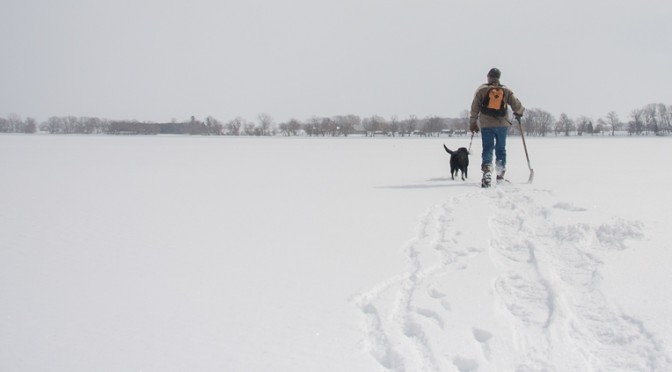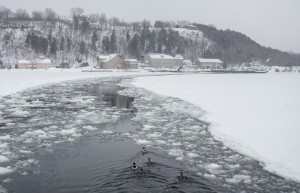“I’m in,” I tell Christoph.
Half an hour later we’re loading up snowshoes, a stack of sandwiches, and Tinkerbell the black Lab. It feels good to be heading outside again after months of hibernation. I am sick of the coldest winter in 20 years, but there are benefits.
He’s called the farmer that morning, who gives assurance that if the ice can bear the weight of his tractor it is sure to hold us.
Still, it’s our first time on an ice bridge and our natural instinct says it’s unnatural to walk across a body of water, even if it is frozen. We stand above the shoreline, atop a shoulder-high pile of plowed snow, grinning at each other. We see no tracks, human or tractor-made.
“Are you nervous?” I ask him. “A bit,” he admits, popping Tink on her leash. “But if I fall in she’ll keep me afloat.” I hang back a little, then follow in his footsteps knowing I’m both lighter and closer to shore. Before long we’ll both be in the middle and any advantage will be lost.
Two hours we drove under pale grey skies, amid a torrent of salty sludge courtesy of transport trucks on their way to Toronto. A tankful of washing fluid made no difference; it is a messy, yet promising, sign of spring. We boarded the Glenora ferry, sweeping our way through the sliver of open water. A raft of ducks bobbed and dove in the bow wave, desperate for food, weakened by the cold, and painfully slow to move out of harm’s way. A half-dozen bald eagles, circling black against white, eyed the ducks like fish in a barrel and filled their own bellies to bursting. No advantage is lost in nature.
The wind blows most fiercely half a kilometre or so from shore, but we are rewarded with growing patches of winter blue. We turn our backs to the wind and lift our faces to the sky. By the end of the day we will have reddish noses and rosy cheeks, welcome colour in a monochromatic season. I snap photo after photo of the shifting light and landscape in all directions, and of our broad smiles against the thin strip of distant island. By the time we reach the far shore we are unzipping our jackets, sweaty and snow blind, and my camera batteries are dead.
We have come to check on the bunkie, which I am helping to build. Although the gable ends are mostly open, there is little snow inside and everything’s in good order. It sits in the hollow of a snow bowl, the wide eaves and a cooperative Mother Nature exposing a circular skirt of dun-coloured ground around its footings. Satisfied, we snowshoe back down the bank, heading towards the main house. I am stepping over a steering wheel when I appreciate just how much snow there has been this year: I am suspended a meter above the deck of the enormous steel barge without noticing it is there.
Christoph unlocks the front door while I restrain the screen which hangs by one hinge. The house stores the summer goods – the bikes, lifejackets, barbeque and tools – and provides rustic protection from the elements. I venture out to the dunny as he sets two Adirondack chairs in the snow. Since my summer visit, another bird nest has sprouted from the rafters but the view from the three-sided structure remains constant. I lift the lid to discover an ice crystal-encrusted toilet seat. I can tell you I didn’t linger.
We shoot hot sweet tea from teeny-tiny Dixie cups and eat our lunch in near silence, drinking in the view. What had looked like open water from a distance turned out to be only shadows. Later, when we rounded the island, we spotted snow dunes where rough waters would normally have been. The island has become ice-locked, part of this year’s extraordinary Great Lakes freeze up.
We put away the chairs, lock up the house, and head back across the bay, facing a barren canvas. It took little time for the shifting snow to erase our original tracks. For every metre we cover, Tinkerbell covers six. She creates Nazca-like drawings, marking her path with loops and squiggles, and I imagine seeing her artful patterns from above.
By the time we reach the car, she is content to curl up in the backseat and sleep her way home.



